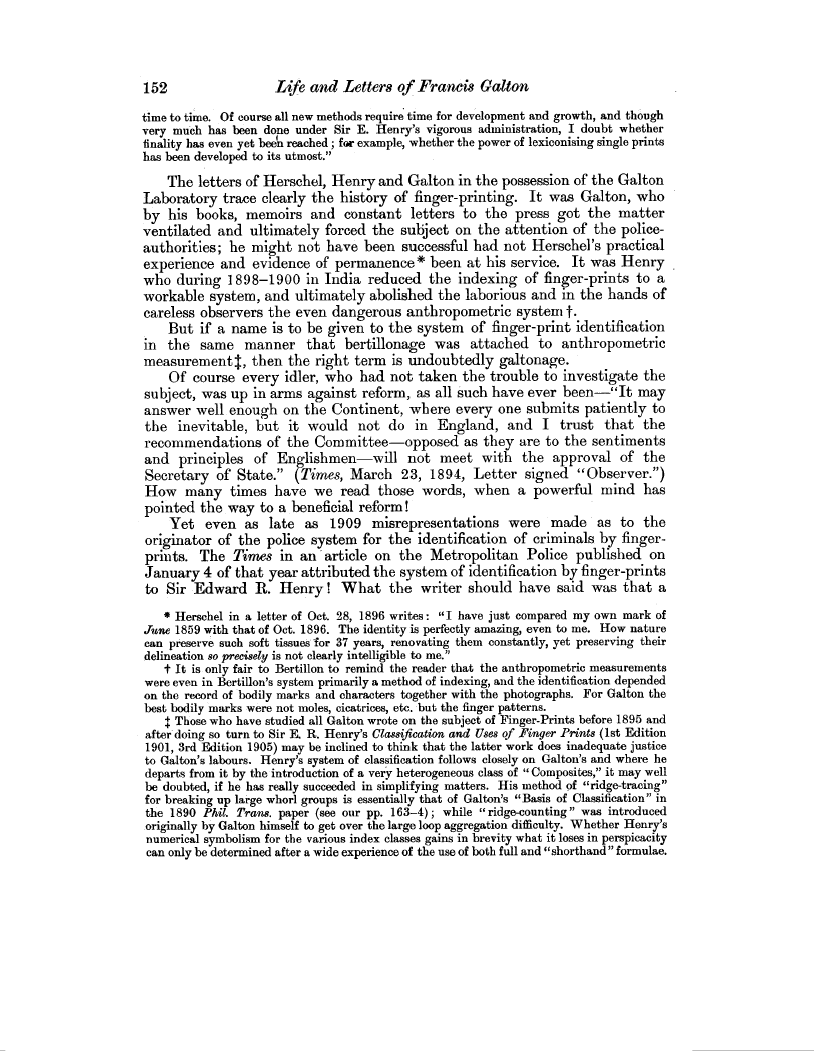| ||||||

OCR Rendition - approximate
152 Life and Letters of Francis Galton time to time. Of course all new methods require time for development and growth, and though very much has been done under Sir E. Henry's vigorous administration, I doubt whether finality has even yet been reached ; for example, whether the power of lexiconising single prints has been developed to its utmost." The letters of Herschel, Henry and Galton in the possession of the Galton Laboratory trace clearly the history of finger-printing. It was Galton, who by his books, memoirs and constant letters to the press got the matter ventilated and ultimately forced the subject on the attention of the policeauthorities; he might not have been successful had not Herschel's practical experience and evidence of permanence* been at his service. It was Henry who during 1898-1900 in India reduced the indexing of finger-prints to a workable system, and ultimately abolished the laborious and in the hands of careless observers the even dangerous antbropometric system j-. But if a name is to be given to the system of finger-print identification in the same manner that bertillonage was attached to anthropometric measurement+, then the right term is undoubtedly galtonage. Of course every idler, who had not taken the trouble to investigate the subject, was up in arms against reform, as all such have ever been-"It may answer well enough on the Continent, where every one submits patiently to the inevitable, but it would not do in England, and I trust that the recommendations of the Committee-opposed as they are to the sentiments and principles of Englishmen-will not meet with the approval of the Secretary of State." (Times, March 23, 1894, Letter signed "Observer.") How many times have we read those words, when a powerful mind has pointed the way to a beneficial reform! Yet even as late as 1909 misrepresentations were made as to the originator of the police system for the identification of criminals by fingerprints. The Times in an article on the Metropolitan Police published on January 4 of that year attributed the system of identification by finger-prints to Sir Edward R. Henry ! What the writer should have said was that a * Herschel in a letter of Oct. 28, 1896 writes : "I have just compared my own mark of June 1859 with that of Oct. 1896. The identity is perfectly amazing, even to me. How nature can preserve such soft tissues for 37 years, renovating them constantly, yet preserving their delineation so precisely is not clearly intelligible to me." t It is only fair to Bertillon to remind the reader that the antbropometric measurements were even in Bertillon's system primarily a method of indexing, and the identification depended on the record of bodily marks and characters together with the photographs. For Galton the best bodily marks were not moles, cicatrices, etc. but the finger patterns. + Those who have studied all Galton wrote on the subject of Finger-Prints before 1895 and after doing so turn to Sir E. R. Henry's Classification and Uses of Finger Prints (1st Edition 1901, 3rd Edition 1905) may be inclined to think that the latter work does inadequate justice to Galton's labours. Henry's system of classification follows closely on Galton's and where he departs from it by the introduction of a very heterogeneous class of "Composites," it may well be doubted, if he has really succeeded in simplifying matters. His method of "ridge-tracing" for breaking up large whorl groups is essentially that of Galton's "Basis of Classification" in the 1890 Phil. Trans. paper (see our pp. 163-4); while "ridge-counting" was introduced originally by Galton himself to get over the large loop aggregation difficulty. Whether Henry's numerical symbolism for the various index classes gains in brevity what it loses in perspicacity can only be determined after a wide experience of the use of both full and "shorthand" formulae.
|